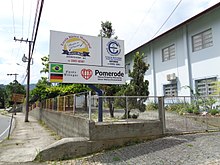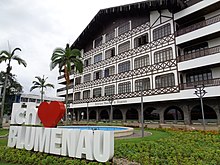German speakers in Latin America
The German speakers are a minority in Latin America , which came about through immigration for various reasons.
Stages of immigration
Before the First World War
Before the First World War , colonization and immigration, promoted by the respective South American governments, dominated.
After the liberation struggles of the South American states in 1820–1825, the state territories were consolidated through reclamation of the fallow land, especially in the border regions. This should be achieved with European immigrants. In the second half of the 19th century, due to the increasing ban on the slave trade, more workers were needed in agriculture. It was sometimes cheaper to bring a whole family to Brazil than to buy an adult slave. With so-called "contracts" many immigrants were lured to South America and after their arrival had to do compulsory labor in order to pay the costs incurred by the crossing. These relationships lasted z. In some cases until after 1900.
After the First World War
After the First World War , during the years of economic recession in Germany, there was steady, economically motivated emigration. Religious and political reasons were added later (e.g. for Jews during the time of National Socialism or also for Russian mennonites ); Immediately after the Second World War, there were also former members of the National Socialist regime who tried to evade criminal prosecution, and between 1945 and 1955 emigrants who wanted to escape the destroyed Germany. Furthermore, in the last 50 years, more and more delegated specialists came to the industrial centers to work for the subsidiaries of German corporations; this is particularly the case in Brazil. Due to the presence of around 1000 German companies with 230,000 employees - based on the number of employees in these companies - São Paulo is considered the "largest German industrial city".
Current state

There are significant settlements today in Argentina (300,000 - 500,000 German-speaking people, including Villa General Belgrano ), Brazil (500,000 - 1.5 million German-speaking people of German origin not included; e.g. in Blumenau , Pomerode and Domingos Martins - see also German-Brazilian ) , Mexico (150,000), Uruguay , Chile (20,000), Paraguay (100,000, most of them Russian mennonites, many of them in Fernheim ), also Belize , Bolivia , Ecuador , Colombia , Mexico , Peru , Venezuela . In some countries there are German-language media that appear regularly , such as the Argentinisches Tageblatt in Argentina, the Condor in Chile, the Deutsche Zeitung , founded in 1897, and the Brasil-Post (1950), the latter two in São Paulo .
Unlike the Russian mennonites or the Germans in the USA , there was always lively economic and social contact with Germany . Nevertheless, the use of the German language is steadily declining. The Russian mennonites usually keep their native language Plautdietsch as a colloquial language.
chronology
- Ninety percent of German emigrants to Latin America in the 19th century went to South Brazil, Northeast Argentina, Paraguay, Uruguay and South Chile .
- Heydt's Prussian rescript made emigration to Brazil more difficult in 1859.
- From 1932 until the emigration ban in 1941, around 100,000 German-speaking Jews came to Latin America.
See also
- Argentine daily newspaper
- Colonia Tovar
- Germans in Chile
- German Brazilian
- German Mexican
- Cities of Blumenau , Pomerode and Dreizehnlinden
literature
- Karl Ilg: Pioneers in Argentina, Chile, Paraguay and Venezuela. The folklore of the German-speaking settlers hiked through the mountains, jungle and steppe . Innsbruck: Tyrolia-Verl., 1976. ISBN 3-7022-1233-7
